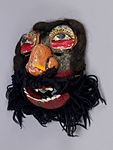Mask
About this object
History of use
Worn during curing ritual of the Sanni Yakuma ceremony, part of the Tovil series of dramas performed by Sinhalese ritual specialists and dancers. The Sanni Yakuma is intended to combat diseases and afflictions caused by the Sanni group of demons. These consist of 18 or more apparitions of the chief demon, Maha-kola-sanni. The officiating healer honours Buddha, then appeases the demons with offerings, dancing, and chanting. This mask represents Salu Paliya, a Pelapali dancer who appears in the second stage of the ceremony. These dancers cleanse the area where the exorcism takes place, invite the Sanni demons, and provide comic relief.
Cultural context
exorcism
Iconographic meaning
The buffon-like face of this ôpoli', is used to portray humourous aspects of the demons.
Physical description
Mask depicting Salu Paliya ("the shawl-clad apparition"). The mask has a fringe of dark brown hair around the top of the head, a black wool beard , and a moustache made of black knit fabric. The facial plane is rubber with eye holes cut in the cheeks, just below the eyes, and is painted black. The eyes and nose are made of wood and are nailed to the rubber. The lips are made from red cloth and tied to the rubber. The lower jaw is moveable. The separate white plastic teeth are sewn into the lips. The prominent nose is curved and painted orange-pink with a yellow and red stripe across the tip. The nostrils are flared, and the crease between the nose and nostril is defined with a black line. The eyes are discs and crescent-shaped with red and yellow eyelids that have radiating black lines. Strips of rubber are tied around centre of each lip and also serve as ties.
